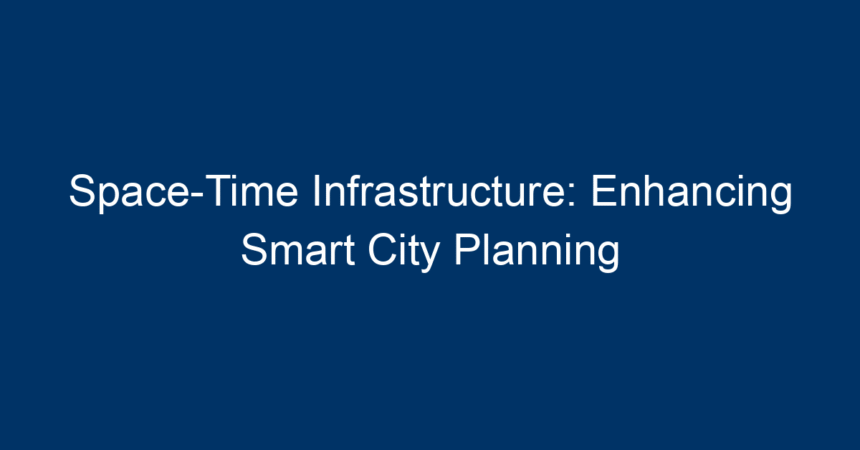In the age of rapid urbanization, cities are reimagining their futures through innovative technologies and strategic planning. The concept of space-time infrastructure is emerging as a cornerstone in enhancing smart cities, allowing urban planners and stakeholders to integrate the dimensions of space and time in their decision-making processes. This article will explore the key components of space-time infrastructure, its benefits for smart city planning, and best practices for its implementation.
What is Space-Time Infrastructure?
Space-time infrastructure refers to a framework that incorporates both spatial and temporal dimensions into urban planning, development, and management. By combining geospatial data with real-time information, city planners can better understand the changing needs of urban environments.
This holistic approach enables smart cities to manage resources efficiently, enhance service delivery, and sustain urban growth while improving quality of life. It encompasses advanced technologies like geographic information systems (GIS), real-time data analytics, and Internet of Things (IoT) devices.
Core Components of Space-Time Infrastructure
-
Geospatial Data Integration
At the heart of space-time infrastructure is the integration of geospatial data. This data provides a foundation for understanding urban landscapes. Urban planners can visualize land use, population density, and infrastructure locations, which aids in effective decision-making. -
Real-Time Monitoring
Smart cities leverage IoT devices to gather real-time data on traffic flow, air quality, and energy consumption. This real-time monitoring allows for dynamic adjustments in city management, improving overall efficiency. -
Predictive Analytics
Combining historical data with current trends enables planners to predict future urban challenges. Predictive analytics can identify areas at risk of congestion or infrastructure failure, thereby enabling proactive interventions. - Interconnectivity
Effective space-time infrastructure requires systems to be interconnected. This integration ensures that data flows seamlessly between various city departments, facilitating coordinated responses to urban issues.
The Importance of Space-Time Infrastructure in Smart City Planning
Enhancing Decision-Making
Integrating space-time infrastructure into smart city planning can significantly enhance decision-making processes. Urban planners can analyze complex datasets more effectively, predicting needs and trends that can inform public policies.
For instance, a city experiencing population growth can use real-time data to adjust public transportation routes, ensuring they adapt to the demographic changes in real time.
Improved Resource Management
One of the crucial benefits of space-time infrastructure is improved resource management. By examining how people use public spaces over time, cities can optimize the allocation of resources such as water, energy, and public transport. This strategic management is vital for sustainability and can lead to reduced operational costs.
Enhancing Quality of Life
The integration of space and time in urban planning allows for the creation of more livable spaces. Planners can design neighborhoods that respond to citizens’ needs, including parks, public transport, and community facilities. Real-time data can inform decisions about where to place amenities to maximize their benefit to the community.
Case Studies of Space-Time Infrastructure in Action
Barcelona, Spain
Barcelona is often cited as a model for smart city initiatives. The city has implemented a comprehensive space-time infrastructure strategy that integrates IoT devices across its urban landscape. These devices monitor traffic, energy consumption, and air quality, providing real-time data to planners and policymakers.
By leveraging this data, Barcelona has been able to improve public transportation efficiency, reduce pollution levels, and enhance the overall quality of urban life.
Singapore
Singapore’s Urban Redevelopment Authority uses space-time infrastructure to guide its extensive urban development projects. The integration of geospatial data and real-time analytics informs everything from land use planning to transportation systems.
This approach has allowed Singapore to maintain its reputation as one of the most liveable cities globally, providing residents with seamless public services and high-quality urban spaces.
Implementing Space-Time Infrastructure: Best Practices
To harness the full potential of space-time infrastructure in smart city planning, municipalities should adopt the following best practices:
Invest in Technology
Investing in advanced technologies such as GIS, AI, and IoT is fundamental. These tools are essential for gathering, analyzing, and visualizing data across both spatial and temporal dimensions.
Foster Interdepartmental Collaboration
Establishing a culture of interdepartmental collaboration can enhance data sharing and communication. When various city departments work together, they can create a cohesive approach to urban planning.
Engage with Citizens
Public engagement is vital for the success of space-time infrastructure initiatives. Cities should actively involve residents in the planning process through surveys and public forums. This involvement not only enhances transparency but also ensures that the infrastructure aligns with community needs.
Continuously Analyze and Adapt
Urban environments are dynamic, requiring continuous monitoring and adaptation of strategies. Cities should implement feedback loops to assess the effectiveness of their space-time infrastructure initiatives continually.
Challenges and Considerations
While the benefits of space-time infrastructure are compelling, implementing such a comprehensive framework is not without challenges. Data privacy concerns, the digital divide, and the need for significant upfront investment can impede progress.
Cities must navigate these challenges by establishing robust data governance frameworks, ensuring all community members have access to technology, and securing funding for long-term projects.
Conclusion: The Future of Space-Time Infrastructure in Smart Cities
Incorporating space-time infrastructure into smart city planning is not just an advancement in technology; it’s a paradigm shift that redefines how cities can function. By integrating geospatial data with real-time analytics, urban planners can create resilient, efficient, and livable urban environments.
As cities continue to grow and evolve, the effective implementation of space-time infrastructure will be crucial for navigating urban challenges and embracing opportunities.
For stakeholders involved in smart city planning, here are actionable insights:
- Start Small: Begin with pilot projects to test the effectiveness of space-time frameworks and gather community feedback before scaling up.
- Focus on Interoperability: Ensure that new technologies can work seamlessly with existing systems to facilitate data sharing and collaboration.
- Engage Communities: Keep the lines of communication open with residents to foster trust and ensure that urban planning reflects their needs.
In conclusion, the thoughtful application of space-time infrastructure can revolutionize our approach to urban living, making cities smarter, more efficient, and ultimately more enjoyable for everyone.




